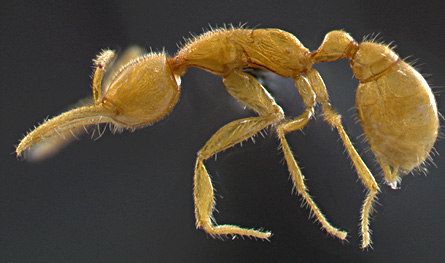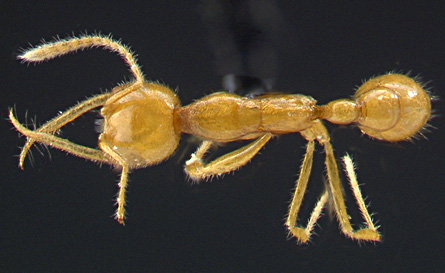Weird, new ant
Recently discovered South American species shakes up ant family tree
By Emily Sohn
 |
|
The newly discovered ant, with mouthparts like forceps and no eyes, lives under the ground in South America.
|
| C. Rabeling, M. Verhaagh |
In the Amazon rainforests of Brazil, scientists have discovered a peculiar new species of ant. The insect has no eyes. Its body is pale. And its fanglike mouthparts are longer than the rest of its head.
If you happened to cross paths with the bizarre ant, you might imagine that it belongs on another planet. Even its name — Martialis heureka — playfully suggests that it came from Mars.
But Martialis heureka lives on Earth. And the creepy-crawly discovery is forcing researchers to rethink what they know about the history of ants on our planet.
Christian Rabeling, from the University of Texas at Austin, discovered the new species amid the fallen leaves of the rainforest. But he did more than just notice how weird the ant looks. He also analyzed its genetic material, or DNA.
Comparing DNA among species can give scientists insights into family trees: The more DNA two species share in common, the more closely related they are, and the more recently they split off from a common ancestor.
Rabeling’s DNA analysis of Martialis heureka showed that the species is only distantly related to other ant species. It is so distant, in fact, that it belongs in a separate subfamily — a broader grouping than a species or even a genus. The last time scientists found a new subfamily of living ants was in 1923, say the discoverers.
 |
|
Scientists looked at the ant’s genes to find out where it fits in the ant family tree. They showed that the odd ant may come from the earliest branch of the ant family that still has living members.
|
| C. Rabeling, M. Verhaagh |
The DNA analysis also suggests that Martialis heureka appeared on Earth earlier than any other ant living here today. And observations suggest that the ant lives underground: Paleness and blindness are two major clues.
Some of the other oldest known ant species also live underground. So now, scientists are trying to figure out whether ants first evolved underground, or if they evolved above ground and then went under.
Corrie Moreau, an ant specialist at the Field Museum in Chicago, saw a picture of the new creature. “It’s an incredibly bizarre-looking ant … which for ant biologists is really exciting,” she says. A few other ant species have at least one of Martialis heureka’s weird features, she says. But none share them all.
So far, Rabeling has collected only one ant from the new species. Finding more specimens, he hopes, will help us better understand the science and history of ants on Earth.







